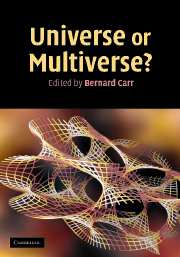Book contents
- Frontmatter
- Contents
- List of contributors
- Preface
- Acknowledgements
- Editorial note
- Part I Overviews
- Part II Cosmology and astrophysics
- Part III Particle physics and quantum theory
- Part IV More general philosophical issues
- 20 Scientific alternatives to the anthropic principle
- 21 Making predictions in a multiverse: conundrums, dangers, coincidences
- 22 Multiverses: description, uniqueness and testing
- 23 Predictions and tests of multiverse theories
- 24 Observation selection theory and cosmological fine-tuning
- 25 Are anthropic arguments, involving multiverses and beyond, legitimate?
- 26 The multiverse hypothesis: a theistic perspective
- 27 Living in a simulated universe
- 28 Universes galore: where will it all end?
- Index
- References
22 - Multiverses: description, uniqueness and testing
Published online by Cambridge University Press: 05 July 2014
- Frontmatter
- Contents
- List of contributors
- Preface
- Acknowledgements
- Editorial note
- Part I Overviews
- Part II Cosmology and astrophysics
- Part III Particle physics and quantum theory
- Part IV More general philosophical issues
- 20 Scientific alternatives to the anthropic principle
- 21 Making predictions in a multiverse: conundrums, dangers, coincidences
- 22 Multiverses: description, uniqueness and testing
- 23 Predictions and tests of multiverse theories
- 24 Observation selection theory and cosmological fine-tuning
- 25 Are anthropic arguments, involving multiverses and beyond, legitimate?
- 26 The multiverse hypothesis: a theistic perspective
- 27 Living in a simulated universe
- 28 Universes galore: where will it all end?
- Index
- References
Summary
Introduction
The idea of a multiverse – an ensemble of universes or expanding domains like the one we see around us – has recently received increasing attention in cosmology. It has been conceived of as occurring either in separate places or times in the same overall encompassing universe (as in chaotic inflation) or through splitting of the quantum wave-function (as in the Everett interpretation of quantum mechanics) or as a set of totally disjoint universes, with no causal connection whatsoever. Physical properties may be different in the different universes or in different expanding domains within a single universe.
In this context, definitions are important. Some workers refer to the separate expanding regions in chaotic inflation as ‘universes’, even though they have a common causal origin and are all part of the same single spacetime. In keeping with long established use, I prefer to use the word ‘universe’ to refer to the single unique connected spacetime of which our observed region (centred on our galaxy and bounded by our visual horizon in the past) is a part. I will describe situations such as chaotic inflation — with many expanding domains — as a ‘multi-domain universe’. Then we can reserve the term ‘multiverse’ for a collection of genuinely disconnected spacetimes, which are not causally related. When the discussion pertains to both disjoint collections of universes and different domains of a multi-domain universe, I will refer to an ‘ensemble of universe domains’ or ‘ensemble’ for short.
- Type
- Chapter
- Information
- Universe or Multiverse? , pp. 387 - 410Publisher: Cambridge University PressPrint publication year: 2007
References
- 11
- Cited by



